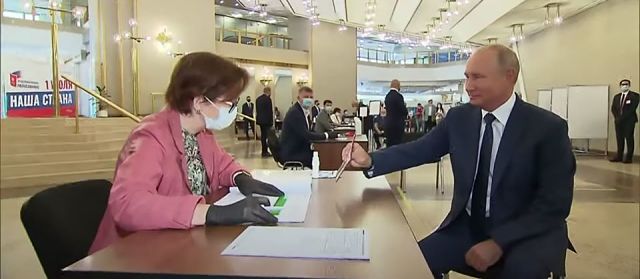“The de facto triumphant vote of confidence in President Vladimir Putin,” Kremlin spokesman Dmitry Peskov commented on the spectacle of the past few days.
Here are some excerpts from the analysis of renowned opposition activist Leonid Volkov (emphasis in the text is GI’s).
The end of Putin’s majority. Quick calculations in the heat of the moment. Even in 2018, despite the exclusion of competitors and massive falsifications (which, according to respected researchers, amounted to about 10-12 million votes), one could speak of a stable pro-government majority. About 45 million people actually voted for Putin then, and even with all the reservations about administrative pressure, unequal conditions, etc., even if he had renounced falsifications in 2018 and allowed independent candidates, it would have been enough to win.
In 2020, the situation has changed radically. It is a new political reality. As I can see from Shpilkin’s graphs, the actual turnout for the amendments was about 40%. (Pamfilova officially announced 65%, of which 55% – more than five-sixths – allegedly voted early. This means that almost half of the turnout during the week of voting was artificially constructed for the purpose of ‘legalizing’ millions of early ballots).
As has been said many times, the process, with no outside oversight, was designed to produce a predetermined result regardless of the actual turnout and election results. And that’s what they did: 78% in favor with a 65% voter turnout gives a clean 50.7% of all voters, or 55.3 million votes. Taking into account the actual turnout of about 40%, we can deduce that the number of falsifications (let’s call all falsifications: stuffing, fictitiously composed protocols, adjusted protocols, and invented early voting results) amounted to about 27.3 million votes. That is HALF of the official Putin result. Almost three times more than the falsifications in the Putin-2018 and State Duma-2016 elections.
Each time, 10-12 million votes were falsified, mainly in traditional electoral strongholds such as Kuban, Chechnya, Dagestan, the Kemerovo region, and so on.
But it is impossible to get 27 million votes this way, so, as we said, the falsifications were total. Mass falsification in Moscow, even more massive in St. Petersburg, almost in all regions of the Central Federal District. Even in the prosperous city of Ekaterinburg there were completely fake polling stations – not to mention the regions where the counting was never taken seriously. (By the way, the Khanty-Mansiysk Autonomous Okrug surprised in this regard – it used to be a typical “sultanate”, but this time the counting was done quite properly. It’s interesting why).
The more or less real voting results (taking into account late voting and administrative pressure, but excluding falsifications) look something like this (with an accuracy of plus or minus a few million; of course Shpilkin et al. will do a much better count): turnout of about 40% (i.e. about 43.6 million voters), of which about 28 million voted for the amendments and 15 million voted against. That is, about 64% in favor of the amendments – which a) corresponds to the results in electorally rich regions such as the Sverdlovsk, Novosibirsk, Irkutsk regions, etc., and b) perfectly matches the results of published social surveys (including the FBK sociological service).
It is clear that even in this 64% a significant part consists of voters who voted under administrative pressure, but even if we turn a blind eye to this, the result is impressive. In just two years, Putin has lost more than a third of his electoral base; the drop from 45 million to 28 million votes is very dramatic. There is no longer a Putin majority. More than a third of the voters are a solid protest electorate, and even more are undecided or unclear about the situation, which can be worked with… “Well, work, brothers…”

